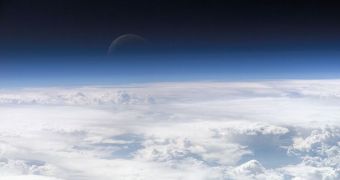New studies appear to suggest that either all or part of our planet's atmosphere did not originate within the Earth – as studies suggest – but was rather brought here by space impactors such as comets and asteroids. A new research proposes a little tweak to these ideas.
University of Manchester investigators led by Dr. Greg Holland say that the atmosphere we breathe was brought down to the planet by space impacts who collided with the planet after it fully formed.
One of the reasons for debate in the international astronomical community is whether a tumultuous time known as the Late Heavy Bombardment is responsible for pulling the chemicals that make up air from the ground, or if the atmosphere slowly vented out, or if it was brought from space.
Interestingly, in the grand scheme of things, this doesn't really matter, considering that everything in the solar system – Sun, planets, moons, impactors, gas, dust and other debris – originally came from one massive interstellar gas cloud, Daily Galaxy reports.
In order to discover some of the sources of chemicals in the atmosphere, researchers conducted chemical analysis on samples collected from the atmosphere, as well as from depths of hundreds of meters below the surface.
They were monitoring isotope ratios. An isotope is a nuclear variant of a given element, and it can be used to determine the source of that element. For example, the isotopes of hydrogen formed near the Sun are different from the ones here on Earth.
The number of neutrons is the primary variable in isotopes. When looking at isotope ratios in a certain sample, experts can determine the origins of that sample with a fairly high degree of certainty.
When comparing isotope ratios of samples collected from the underground, the atmosphere and meteorite samples, experts determined that they were all different. However, they also noticed that the isotope ratios of the atmosphere were the same as those in clouds of interplanetary gas.
These clouds had been swept away by our own planet's gravity, back in the days when the solar system was very young, and Earth had just solidified. What this means, Holland says, is that the largest part of our atmosphere may have been acquired after Earth formed.
The underground may have contributed to some extent, but the bulk of air was simply accreted as Earth flew through or past a large gas cloud. The formation was most likely left behind after the Sun formed.

 14 DAY TRIAL //
14 DAY TRIAL //